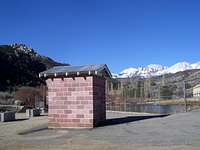-
 3908 Hits
3908 Hits
-
 84.27% Score
84.27% Score
-
 18 Votes
18 Votes
|
|
Mountain/Rock |
|---|---|
|
|
37.30330°N / 118.5242°W |
|
|
Inyo |
|
|
Trad Climbing |
|
|
Spring, Summer, Fall, Winter |
|
|
6800 ft / 2073 m |
|
|
Overview

Frontier is a rock formation in The Little Egypt area of the Eastern Sierras.
Frontier consists of a collection of rocks that in the past were a part of a singular granite dome. Earthquacks and other geologic activity caused large sections of the original fromation to break off, and some have rolled all the way down into the nearby basin. Frontier is a long and complex formation; therefore, I have decided to cover the formation in two separate pages. I will start with the left side, or the north end, to roughly middle of the formation on this page.
Frontier is the first of the three formations in the Little Egypt area, and the first one you come to as you make the approach hike up a steep brush-covered hill. The Frontier complex is really not visible from the road. All you see is the upper parts of the beautiful domes behind Frontier. I am not surprised no one had really bothered to hike up the hill that had no trails to explore the nature of what little was visible from down below. In the early 1970s, the golden age of big wall first ascents in Yosemite Valley seemed to be coming to an end, and climbers were getting more and more curious about the Sierras back country possibilities. Little Egypt seemed to fill the ticket.
Routes of the left side
It was not until the the late 1970s to the early part of the 1980s that the first climbs were established on the Frontier. Of the first early hardmen to establish routes on the Frontier’s left side, one was none other than Alan Bartlett with his first ascent of one of the best climbs on the entire formation, Classic Crack, rated 10a. Another climber to establish routes on the Frontier’s left side was, Tony Puppo with his climb of, Hieroglyphics, 5.9. During the 1980s, when sport climbing seemed to keep the younger generation of climbers busy on bolted faces, several of the veteran hardmen were establishing routes on the Frontier’s upper face’s cracks. These cracks were all in the 5.11 difficulty level. True to their principles, these back country climbers did not place any bolts next to cracks. They relied entirely on their own abilities and primitive protections of the era.
Note: There is a third class ramp leading to the base of several of the left side’s upper wall cracks. The same ramp turns into a chimney/corner that may be used to get to the base of “ The Gutter.”
Climbs The Frontier, left side | |
| A | Dog Day Afternoon, 11d, standard rack, pro to 2.5" |
| B | Espresso Crack, 11c, standard rack, pro to 3 inches |
| C | Hieroglyphics, 5.9, Standard rack, pro to 2.5 inches |
| D | Flight, 10d, bolts and standard rack |
| E | Classic Crack, 10a, Standard Crack, pro to 3.5 inches |
| F | Grain Tamer, 12c, bolts |
| G | The Gutter, 10c, standard rack |
| H | Rosetta Direct, 12b, bolts |
| I | 4 Those About 2 Rock, 10d, standard rack |
| J | Decaf, 11d, standard rack, pro to 3.5 inches |
Best Seasons to climb:
Frontier is a west facing formation and stays in the shade for a good part of the day. This fact, in addition to its altitude of over seven thousand feet, makes it an ideal rock for climbing during the warmer seasons. During the winter months, however, the weather can be stingingly cold and the approach hill buried under several feet of snow. I personally think fall and spring are the best seasons for climbing here.
When you do make the approack, take a few minutes to soak in the mountains views from here. You get some incredible views of Mount Tom, Four Gables, Basin Mountain, Mount Humphreys and Mount Emerson, from right to left. Carry plenty of water. There are no running creeks in this area.
Camping
There are many campgrounds along Bishop Creek. There are also many places in The Buttermilks are that are close to a creek that are suitable for camping. Please do not camp in The Buttermilks bouldering area. That area is very crowded and is suffering from the impact unregulated camping has caused.The following links should help finding a good campsite
Horton Creek Campground
Rock Creek Canyon
Inyo National Forest
Bishop Creek and vicinity camping














